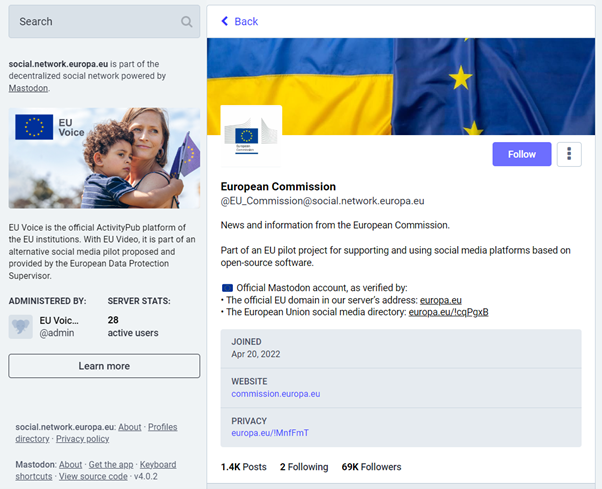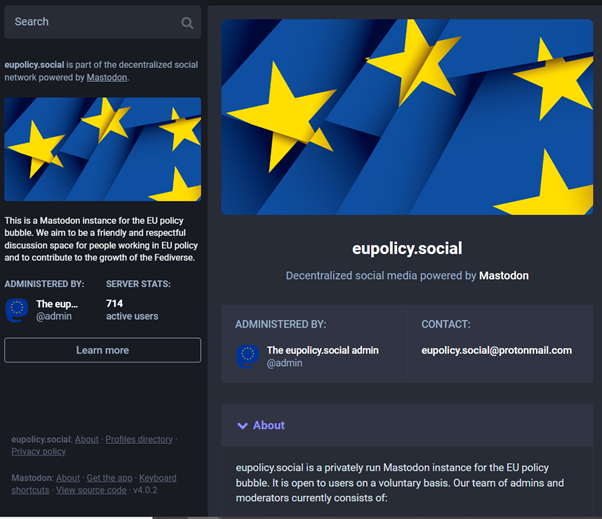
social media
EU Bubble dwellers: Should you switch from Twitter to Mastodon?
Last year ended on turbulent weeks for Twitter. Marked by lay-offs, random blue tick attribution chaos and plummeting advertising sales, Elon Musk’s platform’s credibility and changing policies have been causing its users to reconsider. Many are thinking about leaving – or have left already – the platform for Mastodon, a similar decentralised social network. The Twitter alternative has skyrocketed in popularity, leaping from 300,000 monthly active users to 2.5 million between October and November 2022.
What does this phenomenon mean for the so very specific Twitterverse of Brussels’ EU bubble? The platform, so dear to MEPs, the media and other stakeholders willing to inform, have their say and influence, has been the go-to tool to convey messages in 280 characters for years. Well, it was the case for most journalists until E. Musk’s abruptly decided to suspend the account of several reporters back in the US, and caused them to have shivers down their spine.
The Twitter Brussels office’s closure last November 2022 – following the departure of two senior employees responsible for ensuring the company’s compliance with the bloc’s landmark Digital Services Act (DSA) – sparked concerns on whether the social media platform would abide by the new EU rules on policing online content in the future. Breton confirmed the bird would fly by EU rules.
What is Mastodon and how much does it differ from Twitter?
At first glance, it seems a simple copy of Twitter with many similar functions. However, the notable difference lies in its decentralised nature. Open-source, Mastodon is made of multiply servers (called “instances”), mini social networks within the platform, if you will. Anyone can run or host their own space for a few euros a month. This allows communities to gather around a specific topic, each group having its own set of rules and moderation. If you don’t like what’s being said in the conversation, or people in it, you are free to move to another instance.
Why choose Mastodon? Because it’s decentralized and open-source, it can’t be sold and won’t go bankrupt. It respects your privacy and gives control over the network to the people. It’s a product on top of a protocol, the way Twitter should have been.
— Mastodon (@Mastodon@mastodon.social) (@joinmastodon) October 27, 2022
Other divergences include messages limited to 500 characters, and tweets called “toots”. You put toots in “favourite”, you don’t drop likes, and you “boost or reblog” posts instead of retweeting. And it seems generally less user-friendly than Twitter. Did you know it was originally created by Eugen Rochko, a German software developer?
When it comes to (political) advertising on there, the answer is straightforward: there is none. You cannot advertise on this platform, which makes its content 100% organic.
No ads, no controversy
One feature Twitter does not have is the option to partly hide a post containing a spoiler or controversial political content, behind a screen only removed if the user chooses it. On Mastodon, the user is put back in a position of control when it comes to engaging with politics on the platform.
When it comes to (political) advertising on there, the answer is straightforward: there is none. You cannot advertise on this platform, which makes its content 100% organic. While ads are one of Twitter’s main sources of revenue, Mastodon is not profit motivated and can afford to stay small.
The bubble has landed on Mastodon–and might be here to stay
In the bubble, many institutions and #EUInfluencers are already present on Mastodon. The European Commission joined on 20 April 2022, part of the “social.network.europa.eu” instance and gathers over 69K followers to date. The server is owned and managed by EU Voice, the official microblogging platform of the EU institutions bodies and agencies–part of an alternative media pilot program.
Is your target EU bubble audience on Mastodon? The EU Commission account gathers over 69K followers so we may have an answer about the interest in itself, only partial however, given that not many communications tools out there provide an audience analysis of accounts and servers on the platform (yet).

Source: Mastodon at social.network.europa.eu
One thing is certain. The EU ecosystem has slowly but surely been landing on Mastodon, from Margrethe Vestager to the EU Agency for the Space Programme (EUSPA) and the media such as Euractiv. EU bubble influencers such as Jon Worth (@jon@gruene.social – 8,9K followers) or Chris Kendall (@ottocrat – 3,5K followers) are on there too and many people are following what they have to say. Other communities, such as eupolicy.social, are also shaping around policy topics.

Source: Mastodon at eupolicy.social
One thing is certain. The EU ecosystem has slowly but surely been landing on Mastodon.
So, is Mastodon a viable alternative to Twitter?
The core of a social media network being its audience, it all goes down to whether the people and organisations you are conversing with are switching or not. Unless you or your organisation are politically taking a stance against Elon Musk, the direction Twitter is going towards and its centralised structure, Mastodon should be seen as a complement to Twitter more than a replacement in the bubble.
Mastodon is worth trying out, however, if this core audience you aim to reach is using the platform. If you are an association tackling a technical matter, the platform could host your niche community. The bubble is partly there, but the scope is more minor than Twitter and more or less the same messages – with some toots being copies of tweets.
The natural alternative to Twitter these days seems to be… LinkedIn.